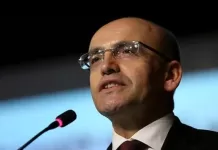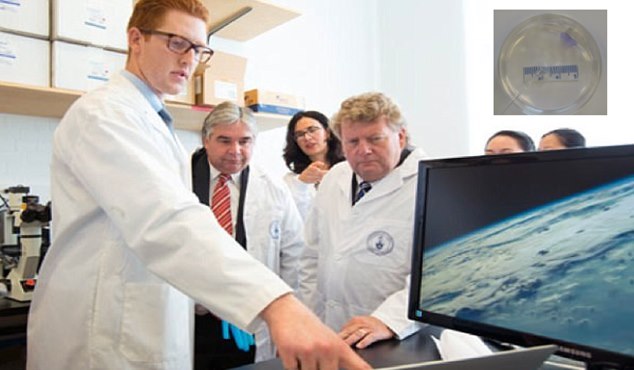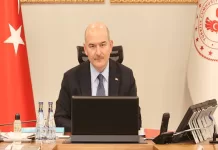The AngioChip is made of a biodegradable scaffold with lab-grown heart cells
Researchers from the University of Toronto have developed the new device, called the AngioChip, which is a tiny patch of heart tissue with its own blood vessels.
How to mend a broken heart: Scientists develop an injectable tissue bandage the size of a POSTAGE STAMP that could remove the need for invasive surgery
Repairing cardiac tissue after a heart attack usually requires invasive open-heart surgery, which comes with severe risks, including chest infections and memory loss.
But the risky operations could soon be a thing of the past, thanks to an incredible new injectable tissue bandage.
The bandage, which is the same size as a postage stamp, can be injected using a small needle – although the researchers stress that more research is needed before it is used on patients.
ANGIOCHIP DEVICE
[toggle title=”ANGIOCHIP DEVICE” state=”open” ]
The team has spent nearly three years developing a patch that could be injected, rather than implanted.
After multiple attempts, the researchers found a design that matched the mechanical properties of the target tissue, and had the required shape-memory behaviour.
As the tissue emerges from the needle, the patch unfolds itself into a bandage-like shape.
Once it had been designed, the next step was to grow the patch with real heart cells.
After letting them grow for a few days, they injected the patch into rats and pigs.
Not only did the injected patch unfold to nearly the same size as a patch implanted by more invasive methods, but the heart cells survived the procedure well.
The scaffold is built out of the same biocompatible, biodegradable polymer, meaning that over time, the scaffold will naturally break down, leaving behind the new tissue.
[/toggle]
Researchers from the University of Toronto have developed the new device, called the AngioChip, which is a tiny patch of heart tissue with its own blood vessels.
While such lab-grown tissues are already being used to test potential drug candidates for side effects, the team’s long-term goal is to implant them back into the body to repair damage.
Professor Milica Radisic, lead author of the study, said: ‘If an implant requires open-heart surgery, it’s not going to be widely available to patients. It’s just too dangerous.’
The team has spent nearly three years developing a patch that could be injected, rather than implanted.
Mr Miles Montgomery, one of the researchers working on the tissue, said: ‘At the beginning it was a real challenge; there was no template to base my design on and nothing I tried was working.
‘But I took these failures as an indication that I was working on a problem worth solving.’
After multiple attempts, Mr Montgomery found a design that matched the mechanical properties of the target tissue, and had the required shape-memory behaviour.
Small needle can inject scaffold to repair tissue without surgery – AkademiPortal from Akademi Portal on Vimeo.
As the tissue emerges from the needle, the patch unfolds itself into a bandage-like shape.
Professor Radisic said: ‘The shape-memory effect is based on physical properties, not chemical ones.’
This means that the unfolding process doesn’t require additional injections, and won’t be affected by the conditions within the body.
[toggle title=”THE RISKS OF OPEN HEART SURGERY ” state=”open” ]
The injectable mesh could replace the need for open heart surgery, which has a number of risks. These include: Chest wound infection (more common in patients with obesity or diabetes)
-Heart attack or stroke
-Irregular heartbeat
-Lung or kidney failure
-Chest pain and low fever
-Memory loss or ‘fuzziness’
-Blood clot – Blood loss
-Breathing difficulty
Pneumonia Source: HealthLine
[/toggle]
Once it had been designed, the next step was to grow the patch with real heart cells.
After letting them grow for a few days, they injected the patch into rats and pigs.
Not only did the injected patch unfold to nearly the same size as a patch implanted by more invasive methods, but the heart cells survived the procedure well.
Mr Montgomery said: ‘When we saw that the lab-grown cardiac tissue was functional and not affected by the injection process, that was very exciting.
‘Heart cells are extremely sensitive, so if we can do it with them, we can likely do it with other tissues as well.’
Video captures open heart surgery on baby who is just 6 days old -AkademiPortal from Akademi Portal on Vimeo.
The scaffold is built out of the same biocompatible, biodegradable polymer, meaning that over time, the scaffold will naturally break down, leaving behind the new tissue.
The team also found that injecting the patch into rat hearts can improve cardiac function after a heart attack.
After injecting the patch, damaged ventricles pumped more blood than they did without the patch.
Professor Radisic said: ‘It can’t restore the heart back to full health, but if it could be done in a human, we think it would significantly improve quality of life.’
The researchers highlight that there is still a long way to go before the material is ready for clinical trials.
The team has applied for patents on their invention, and is exploring the use of the patch in other organs, including the liver.
Professor Radisic added: ‘You could customise this platform, adding growth factors or other drugs that would encourage tissue regeneration. I think this is one of the coolest things we’ve done.’
[divider]










































